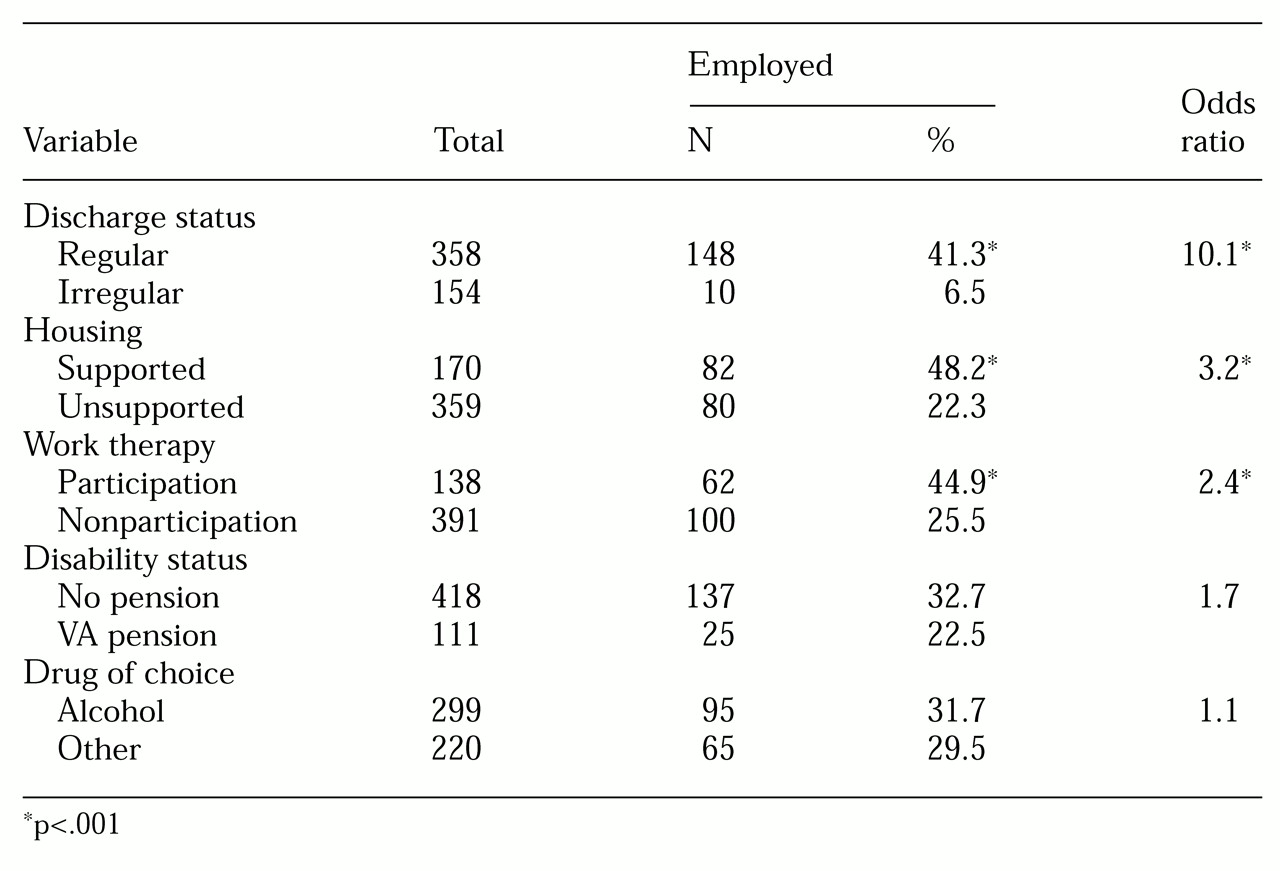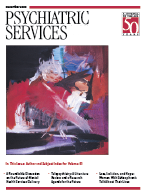In addiction treatment evaluation research, employment is viewed as both a desired outcome and an element of treatment (
1). Moreover, employment may be an essential ingredient for retention in treatment, a variable closely related to treatment outcome (
2). McLellan (
3) found a significant and positive correlation between employment status and retention in treatment.
Gainful employment improves self-esteem, which in turn may reduce the use of illicit drugs. Employment may also serve as a means of social integration. A literature review by Brewington and associates (
4) found that employment is linked to positive clinical outcomes. Furthermore, providing vocational services improves treatment outcomes (
5,
6). Thompson and associates (
7) concluded that vocational rehabilitation clients were more likely to return to work if they received supportive housing coupled with extended aftercare in a drug-free environment. Rosenheck and Seibyl (
8) have researched residential work therapy, but little is known about the outcomes of veterans with substance use disorders who participate in compensated work therapy programs.
The study reported here explored the relationship between the attainment of gainful employment by veterans with substance use disorders and their completion of an addictions partial hospitalization program, receipt of supportive housing, participation in the Veterans Industries work-for-pay program, drug of choice, and disability status.
At the study site, the comprehensive treatment plan for patients with substance use disorders includes assessment and referral for vocational rehabilitation services of patients who participate in an addictions partial hospitalization program. This program treats patients with substance use disorders in a day hospital setting. It is a voluntary program that is offered to patients for whom the most intensive level of care is indicated. Patient detoxification is already completed or is unnecessary. The program's services include group psychotherapy, substance abuse education, case management, and psychopharmacology. Patients in the program are interviewed by a vocational rehabilitation specialist or a counseling psychologist.
All patients are offered the opportunity to participate in a vocational rehabilitation services program, which provides work therapy, job readiness training, assistance with job placement, and subsequent referral to the state vocational rehabilitation service for assistance with supportive housing in a drug-free environment. Abstinence from alcohol and other substance use is a requirement for remaining in the program. The average length of stay in the program is 90 days, but the time frame varies, depending on individual need.
Methods
The 529 veterans who participated in the vocational rehabilitation services program in 1996 and 1997 were the subjects in this study. The mean age of the participants was 43 years, with a range of 22 to 71 years. At the beginning of the program, 518 participants (98 percent) were unemployed, 381 (72 percent) were homeless, and 111 (21 percent) were receiving a disability pension. All the participants met the criteria for a DSM-IV axis I diagnosis of drug or alcohol abuse or dependence; 190 participants (36 percent) had alcohol abuse or dependence, and 339 (64 percent) abused or were dependent on other drugs. Of the latter group, 193 participants (57 percent) abused or were dependent on cocaine.
The outcome measure, or dependent variable, was the percentage of program participants who obtained gainful full-time or part-time employment. The independent variables were the patients' disability status, drug of choice, discharge status, participation in the work-for-pay program, and receipt of supportive housing.
Initially the effect of each independent variable on employment was assessed by analysis of two-by-two tables. SAS/STAT (
9) was used to analyze the data. Statistical significance was determined by Fisher's exact test, and the relationship was estimated by the odds ratio of finding employment. The combined independent variables' relationship with employment was assessed by stepwise logistic regression. The significance of variables in the model was assessed using the chi square statistic, and the combined relationship was estimated by odds ratios.
Results
Of the 529 participants in the vocational rehabilitation program, 358 (68 percent) successfully completed the addictions partial hospitalization program and received a regular discharge; 126 (26 percent) participated in the Veterans Industries work-for-pay program. Of the 381 homeless participants, 122 (32 percent) received supportive housing.
A total of 164 participants (31 percent) obtained gainful employment. As shown in
Table 1, the rate of employment among patients who completed the hospitalization program was 41 percent, as compared to 6 percent among those who did not (χ
2= 61.3, df=1, p<.001). A total of 170 patients (32 percent) received supportive housing, and of those, 82 (48 percent) obtained gainful employment. This rate was significantly higher than the rate of employment among participants who did not receive supportive housing (χ
2=36.6, df=1, p<.001). Of the 138 patients who participated in work therapy (26 percent), 62 (45 percent) obtained employment, a rate significantly higher than for those who did not participate in work therapy (χ
2=17.9, df=1, p<.001).
Stepwise logistic regression identified regular discharge, supported housing, and work therapy as significant predictors of employment, with odds ratios of 8.2 (p<.001), 2.6 (p< .001), and 1.6 (p<.05), respectively.
Discussion
This study describes vocational rehabilitation outcomes of veterans with alcohol and other substance use disorders who were being treated in an addiction partial hospitalization program and also participated in a vocational rehabilitation program. Compared with the study by Rosenheck and Seibyl (
8), our study had a higher percentage of homeless patients—72 percent versus 39 percent—and a lower percentage of patients who were gainfully employed before entering the vocational rehabilitation program—2 percent versus 20 percent.
In accordance with our expectations, the important factors in the return to work of veterans with chronic and severe substance use disorders included the completion of a drug and alcohol treatment program, receipt of supportive housing in a drug-free environment, and participation in work therapy. Contrary to expectations, disability status was not associated with poorer outcome, and the drug of choice did not appear to influence obtaining employment.
Literature reviews spanning a 30-year period suggest that there is a lack of emphasis on vocational services in drug and alcohol treatment as well as underutilization of vocational resources. Arrella and colleagues (
10) have concluded that many persons with drug use disorders receive inadequate vocational rehabilitation services even though they are in treatment and express a desire for these services. Vocational needs can and should be addressed during treatment of addiction.
Our study is limited in that it was retrospective and observational rather than experimental in design. We did not examine our subjects' degree of psychopathology, severity of addiction, or premorbid level of adjustment. The results should be interpreted with these limitations in mind.
Conclusions
Our findings support the conclusions of the
Treatment Research Report (
6) that vocational services improve the employment rates of clients leaving treatment and that job counseling, placement, and development services are positively correlated with the differences in employment rates between admission and discharge. Clients who complete an alcohol and drug treatment program, obtain supportive housing in a drug-free environment, and participate in a work therapy program are more likely to return to work and become fully rehabilitated. Prospective studies are needed to construct a predictive profile of persons who have a higher likelihood of vocational rehabilitation.


